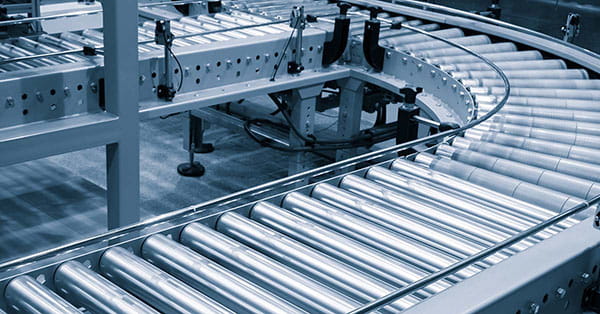North Carolina Conveyor Systems Supplier
Automated conveyors and AS/RS implementations can increase the efficiency of your storage operations, strengthen warehouse safety and meaningfully lower employee costs.
Today’s conveyor systems can move both individual cartons and entire pallets throughout your material handling system, and they are an essential component of contemporary material handling design.
Conveyor systems can be grouped in three distinct classes for most material handling systems:
- Powered belt or roller conveyor systems (for package handling)
- Powered chain or roller conveyors (for pallet handling)
- Non-powered systems
Powered Package Handling Roller or Belt Conveyors
Powered roller or belt conveyors are frequently used for less bulky items like packages and cartons.
Belts are usually used for advancing products along a line, while roller conveyors are employed for collecting packages in specific areas along the line.
Belt Conveyors
In use since the early 1900s, belt conveyors are a fundamental part of most material handling configurations. Not as costly as roller options and frequently more appropriate for certain functions like transporting lighter weight items, belt conveyors have a place in most material handling designs.
Belt systems employ a long, looped belt that is positioned on the top of a metal slider belt substructure or an array of non-powered rollers. A motor drives a pulley that turns the belt and advances objects down the conveyor line.
Belt systems can be made of an assortment of materials and surfaces in accordance with the function and nature of the conveyor. To illustrate, a belt surface could be un-ridged in segments where cartons need to be pushed off the line and may have a gripping surface on segments where goods must be advanced up slopes.
Roller Conveyors
Despite the long and successful history of belt conveyors, newer roller conveyors feature a number of advantages in many modern material handling applications.
Most importantly, roller systems can allow for accumulation of objects on the line where belt conveyors cannot. This is a meaningful distinction because there are innumerable scenarios where products must hold and accumulate in material handling configurations. Accumulation processes are often used when objects must be paused before being relayed to sorters or palletizers.
Some roller conveyor systems also have the ability to monitor items on the line and utilize zero pressure accumulation, meaning none of the accumulating objects come into contact as they slow down and finally stop.
Roller designs are made up of numerous cylindrical rollers that are usually powered in one of three different ways:
- Line shaft conveyors: In a line shaft system, a long metal shaft runs beneath the rollers at a right angle to them and is joined to each roller with flexible O-rings. A drive mechanism rotates the shaft and thereby drives the cylinders by way of the attached O-rings. Line shaft systems are the least costly of all roller conveyors, but they can also demand the most service because the connections between the rollers and the shaft need frequent readjustment and sometimes fail.
- Belt-driven roller conveyors: As you would surmise from the name, belt-driven roller systems are driven by a belt mechanism that lies underneath the roller platform. A motor powers the belt, which propels the roller cylinders.
- MDR conveyors: Motorized roller conveyors, often called motor-driven roller (MDR) conveyors, are built in segments where one cylinder from each section is propelled by its own drive mechanism. That one motor-driven cylinder is joined to the adjacent rollers in that segment via plastic O-rings and consequently rotates all the rollers in the segment. MDR units are placed in succession to create the conveyor line.
Motorized roller conveyors are known for their energy efficiency because: a.) They generally are powered by 24-volt direct current motors and b.) These electric motors are set up to run only when an object is detected on the roller cylinders, meaning they are idle throughout much of the day.
Although motorized roller conveyors cost more than belt drive and line shaft rollers, power costs and service outlays are generally far lower than the other types of conveyors. - Segmented belt conveyor: The principle of MDR conveyors eventually inspired the birth of segmented belt conveyors. Similar to motor-driven roller systems, segmented belts are powered individually and offer a lot of the same benefits of motor-driven rollers, including accumulation capabilities.
Powered Pallet Handling Conveyors
Powered pallet handling conveyors are many times coupled with palletizers and automatic storage and retrieval systems. Pallet handling conveyors can generally deal with loads of up to 4,000 pounds and operate at a far slower pace than carton handling conveyors, often at speeds of two to four pallets per minute.
Pallet handling conveyors come in a couple of varieties: roller conveyors and chain conveyors.
- Pallet handling chain conveyor: Perhaps the most basic of all conveyors, pallets on a chain conveyor line sit on top of segments of heavy-duty chain. Motors propel the chain segments which consequently advance the pallets along the line.
- Pallet handling roller conveyor: Comparable to motor-driven roller conveyors, pallet handling roller configurations use large cylinders and heavy-duty chains to link the motorized cylinder to the rest of the rollers in a conveyor unit.
Non-Powered Conveyors
Roller or skatewheel conveyors are the most prevalent types of non-powered conveyors used in material handling. Non-powered rollers or skatewheels use gravity or inertia to move smaller items through warehouses, pick modules, workstations, automated sorters, loading docks and package-sorting areas.
Skatewheel systems comprise many independent wheels and need minimal energy to maintain the inertia of products as they progress along a conveyor line. In general, they propel items faster than non-powered roller configurations, and they have more adaptability when it comes to layout. Considering they’re separate wheels instead of a belt, they may be applied in curved segments of a conveyor system.
Generally non-powered roller systems are less expensive than skatewheel conveyor systems. They are often utilized for workstations, pick modules and other zones where it’s advantageous to have a level surface to perform tasks. They also decelerate items that originate from higher speed mechanisms like sorters so that human laborers can keep pace with system performance.
Non-powered conveyors have a serious liability as compared with powered conveyors: By applying inertia and gravity to move items, you lose the ability to regulate the force applied to those materials. Simply put, you don’t have influence on the inertia and speed of products on your line.
Conveyor Companies Near Me
If you’d like a complete evaluation of conveyor system options for your warehouse, DC or other material handling operation, talk to an expert at Carolina Handling.
-
-
Proudly serving
Raleigh, Durham,
Cary, Morrisville,
Wake Forest, Apex,
Holly Springs, Garner,
Fuquay-Varina, Clayton,
Knightdale, Chapel Hill,
Jacksonville, Rocky Mount
Wilson, Goldsboro,
and the entire
State of North Carolina
You May Also Like:
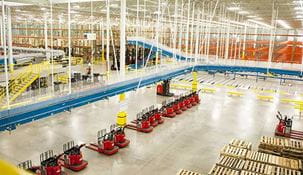
Automation
Carolina Handling can help you automate every aspect of your warehouse operation to increase efficiency.
Learn More
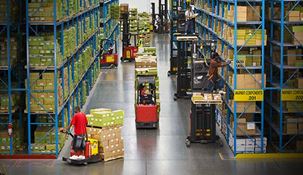
Optimization
Optimize everything in your warehouse to improve productivity and reduce operating costs.
Learn More
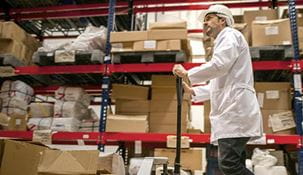
Warehouse Products
Looking for the right product for your operation? We have everything you need to do business in stock.
Learn More
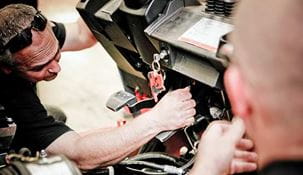
Service Maintenance
Providing superior lift truck service and maintenance for our customers is Carolina Handling's highest priority.
Learn More


